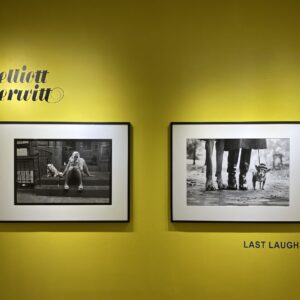JTF (just the facts): Published in 2024 by Spaces Corners (here). Softcover (9 x 12 inches), housed in a reversible, double-hinged cover, 32 pages, with 27 color and black-and-white photographs, offset printed on translucent vellum. Design by Elana Schlenker Studio. (Cover and spread shots below.)
Comments/Context: Melissa Catanese uses photographic images, both personal and anonymous, to produce artist’s books and installations. She is known for her work with the archive of collector Peter J. Cohen, managing and editing a massive collection of snapshots and vernacular photographs (currently it includes some 100,000 photographs, organized into 130 categories). Her now classic photobook Dive Dark Dream Slow was published in 2012, offering a poetic look at found photographs from the early to mid-20th century, sequenced thematically. Earlier this year, she published The Lottery (reviewed here), “a glimpse into an anxious human civilization suspended between uncertain futures.”
As Catanese was working on The Lottery, the California poppy, a fragile yet hardy flower that clusters together, emerged as an early motif. She says that she envisioned the flowers as “figural stand-ins for humans.” She took photographs of fields of poppies in Northern California during the spring of 2021, just as it was experiencing its driest season in more than a century and as the world got hit by the pandemic. So the meaning of the flowers began to “evolve to include messages of grief, remembrance, and a hope for regeneration,” In the end, The Lottery has only one black-and-white image of poppies, appearing in the book’s final coda, and offering a sign of cautious optimism.
As a follow up to The Lottery, Catanese loosened the narrative and imagined it as an transparent wall installation exhibited at “Widening the Lens: Photography, Ecology, and the Contemporary Landscape” at the Carnegie Museum of Art in Pittsburgh, a multi-faceted examination of contemporary ecological issues as they intersect with racial, economic, and political life. The project is documented in an artist’s book that also serves as the exhibition catalogue, as it “embodies the ephemeral and luminescent spirit of this work.”
The publication is housed inside a reversible, double-hinged cover; one side features a bright field with poppies while the other is a grayish texture, resembling a moonscape. Fever Field is printed on translucent vellum. An orange thread binding appears at the very top, matching the color of the flowers, and the placement of the title and the artist’s name indicates that the book unfolds vertically. The images vary in their sizes and placement on pages, creating a dynamic visual flow. A short quote by Virginia Woolf (hardly readable on the transparency) is placed at the very end (and echoes Woolf’s quotes used in The Lottery). Overall, the physicality of Fever Field feels particularly present.
The opening sheet of paper is slightly smaller, offering a square photo of a blurry flower placed at the top left corner, and another horizontal shot of a blurry light filled cloud appears closer to the bottom. The use of translucent vellum creates visible layers of images and overlaps. The shots of the first page then mix with the field of poppy seeds and a strip of green grass underneath. Most of the pages contain images of poppy fields, from full bleed pages dotted with blurry red and yellow flowers to a smaller shot of individual flowers or a pair of flowers. One page has images printed on both sides, creating additional layers and interactions. It is followed by a sheet with a narrow vertical shot of poppy seeds and a black-and-white X-ray of a right hand, adding a darker mood to the flow.
Lines from Virginia Woolf’s most experimental novel The Waves – “all quivers, all kindles, all burns clear” – appear on the very last sheet of paper, together with two other images, of what looks like sunrise at the top and a strip of grass at the very bottom.
Fever Field is a small but intimate project, and between its elegant design and dream-like photographs (with a hint of darkness), it feels both thoughtful and engaging. The images flow in accumulating effect, with individual shots surrendering to the needs of the placement and sequencing, creating a sense of a whole. The project is “an elegy for collective grief, collective loss, personal loss, and political and ecological loss,” and in photobook form, the experience matches that intent.
Collector’s POV: Melissa Catanese does not appear to have consistent gallery representation at this time. As a result, interested collectors should likely follow up directly with the artist via her website (linked in the sidebar.)











